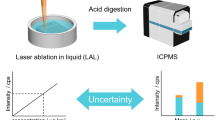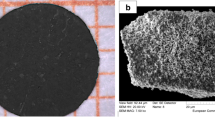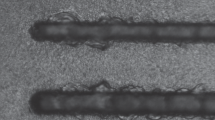Abstract
The laser ablation (LA) method is an effective technique for quantitative analysis. In the present work, a new LA system was developed for the high-sensitivity analysis of metal materials using inductively coupled plasma mass spectrometry (ICP-MS). This system consists of a high-frequency Q-switched laser and 2 scanning mirrors for scanning the ablation spot in an adequately large area of the specimen without vacant spaces. The influence of elemental fractionation (non-stoichiometric generation of vapor species) can be eliminated by repetitive irradiation of this pattern on the same area. Particles generated with an average laser power of 0.6 W with the developed LA system gave intensity and stability substantially similar to that of a 500 mg/ml solution steel sample in solution ICP-MS. The analytical performance of the developed LA-ICP-MS was compared with that of a solution ICP-MS using NIST steel SRMs. The performance of the newly-developed system is comparable to that of conventional solution ICP-MS in both accuracy and precision. The correlation coefficients between the contents and the intensity ratios to Fe were over 0.99 for most elements. The relative standard deviation (RSD) obtained by LA-ICP-MS revealed that this system can analyze iron samples with good precision. The results of ultra trace level analysis of high-purity iron showed that developed LA-ICP-MS is capable of analyzing ppm concentration levels with a 20–30 ppb level standard deviation. The detection limit was on the order of 10 ppb for most elements.
Similar content being viewed by others
References
A. L. Gray, Analyst, 1985, 110, 551.
N. J. G. Pearce, W. T. Perkins, and R. Fuge, J. Anal. At. Spectrom., 1992, 7, 595.
C. Lelope, P. Marty, D. Dall’ava, and M. Perdereau, J. Anal. At. Spectrom., 1997, 12, 945.
M. Guillong and D. Günther, J. Anal. At. Spectrom., 2003, 17, 831.
T. Hirata, Y. Asada, A. Tunheng, T. Ohno, T. Iizuka, Y. Hayano, M. Tanimizu, and Y. Orihashi, Bunseki Kagaku, 2004, 53, 491.
H. Hayashi, T. Nagayasu, S. Furuzawa, and M. Hiraide, Tetsu-to-Hagane, 2004, 90, 17.
S. E. Jackson and D. Günther, J. Anal. At. Spectrom., 2003, 18, 205.
T. Hirata, Anal. Chem., 2003, 75, 228.
R. E. Russo, X. L. Mao, O. V. Borisov, and H. Liu, J. Anal. At. Spectrom., 2000, 15, 1115.
S. M. Eggins, L. P. J. Kinsley, and J. M. G. Shelley, Appl. Surf. Sci., 1998, 129, 278.
P. Arrowsmith, Anal. Chem., 1987, 59, 1437.
Author information
Authors and Affiliations
Corresponding author
Additional information
This is an English edition of the paper which won the Best Paper Award in Bunseki Kagaku, 2006 [Bunseki Kagaku, 2006, 55(4), 229].
Rights and permissions
About this article
Cite this article
Ishida, T., Akiyoshi, T., Sakashita, A. et al. A New Laser Ablation System for Quantitative Analysis of Solid Samples with ICP-MS. ANAL. SCI. 24, 563–569 (2008). https://doi.org/10.2116/analsci.24.563
Published:
Issue Date:
DOI: https://doi.org/10.2116/analsci.24.563




